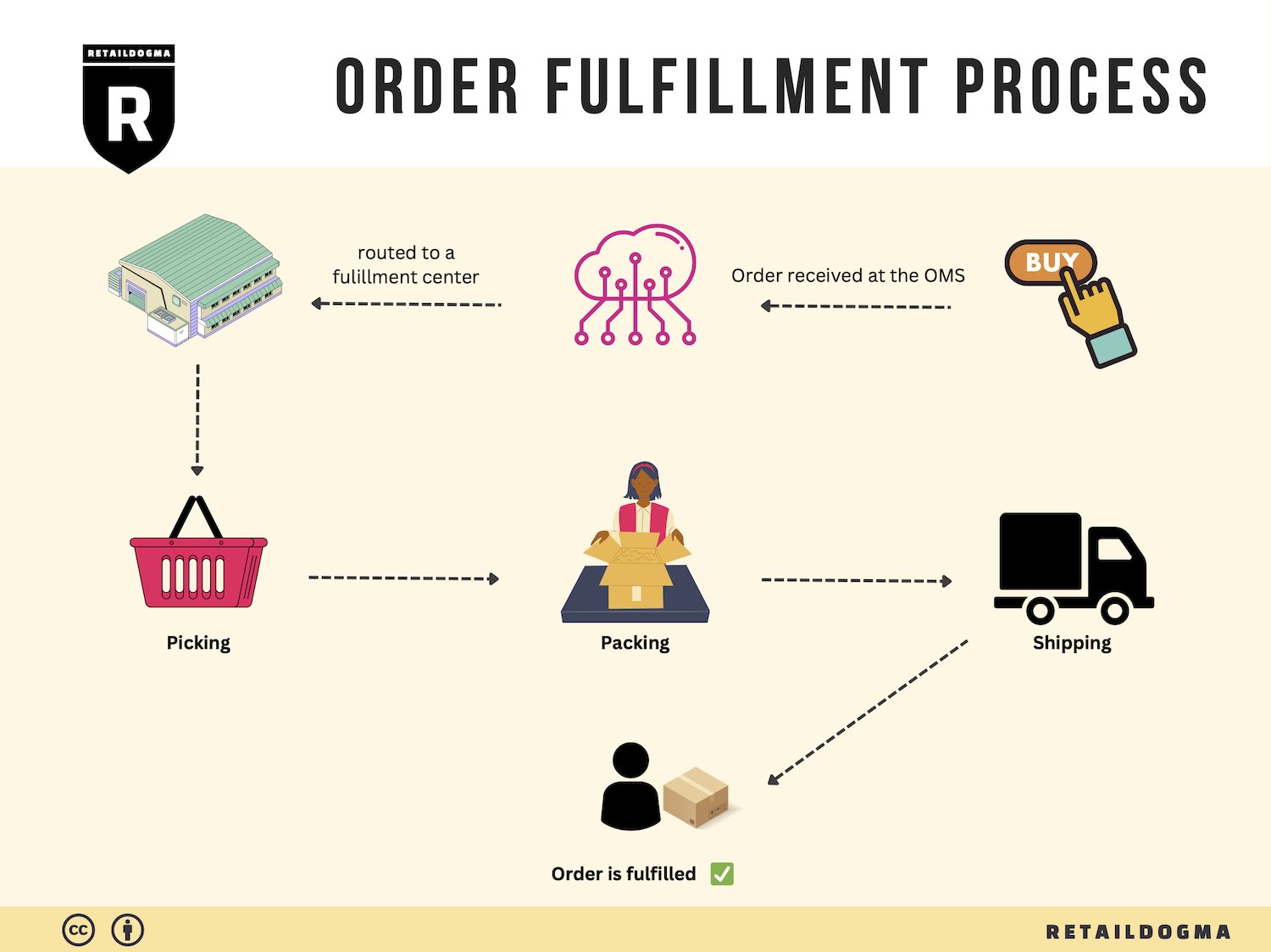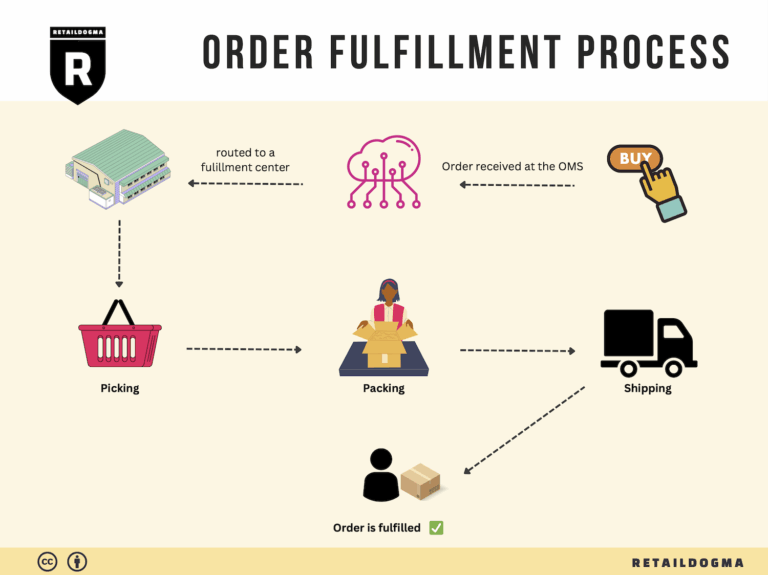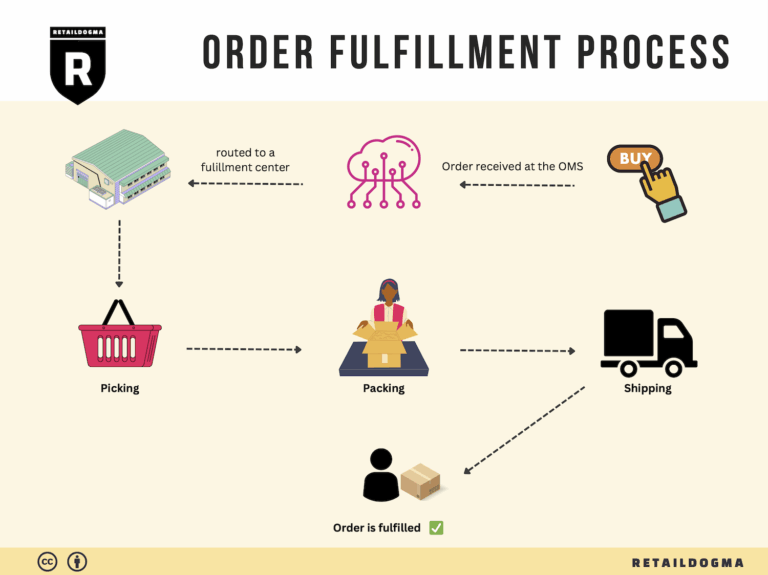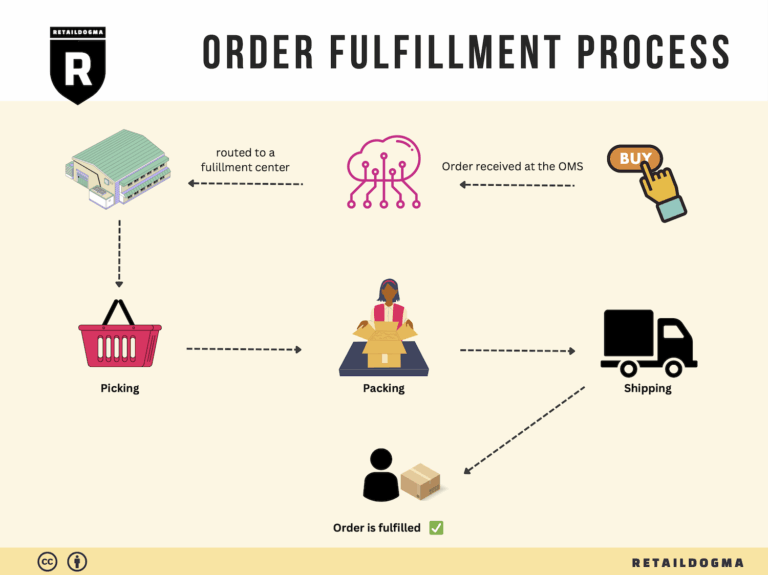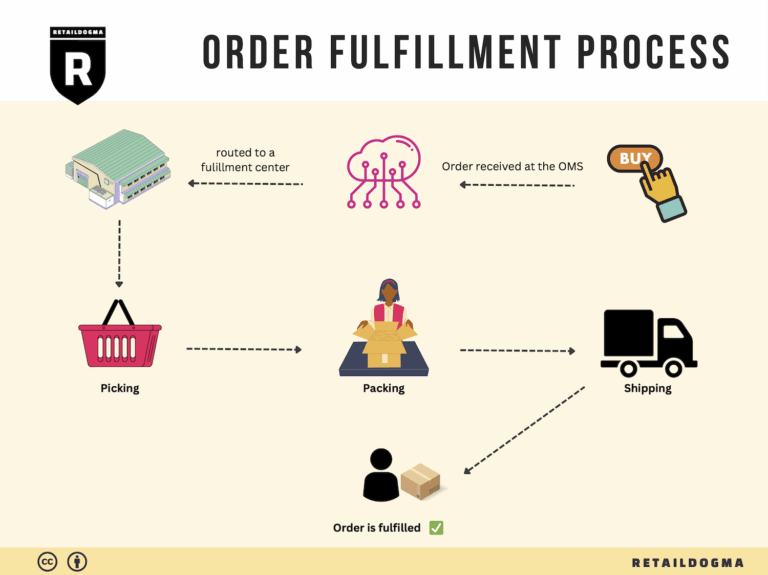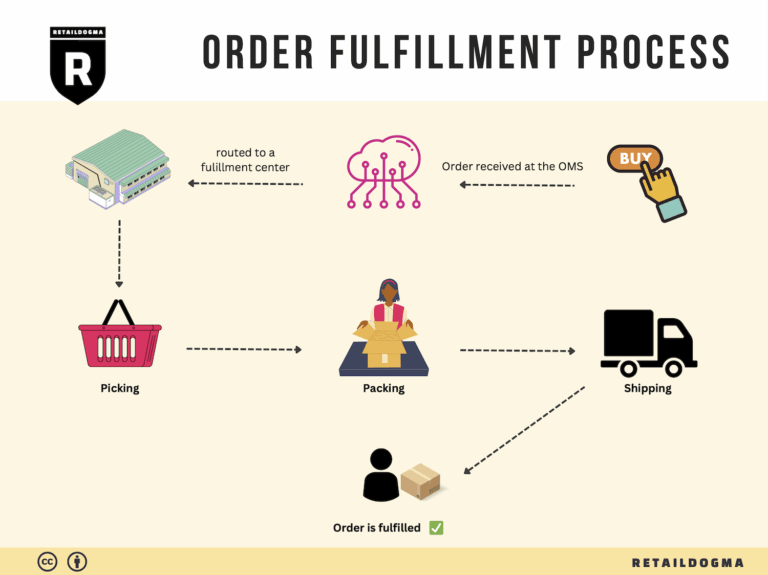What Is A Fulfillment Center? A Complete Guide (2025)
What is E-commerce Fulfillment? An Introduction for Growing Businesses
Understanding E-commerce Fulfillment
For many growing online businesses, the excitement of scaling operations can quickly turn into the stress of managing logistics. As orders begin to pile up, the tasks of packing and shipping can feel overwhelming. This is a common pain point for e-commerce entrepreneurs, who often find themselves bogged down by the intricacies of getting products to customers in a timely and efficient manner.
E-commerce fulfillment is simply the process of storing, picking, packing, and shipping products to customers. It encompasses everything from inventory management to the final delivery of goods. For businesses looking to grow, mastering this process is crucial. A well-structured fulfillment operation not only enhances customer satisfaction through timely deliveries but also allows business owners to focus on core activities like marketing and product development.
In this guide, we will explore the various fulfillment models available to e-commerce businesses, including Third-Party Logistics (3PL) and Fulfillment by Amazon (FBA). Understanding these options will help you determine which model aligns best with your business needs. We will also cover the core services provided by fulfillment centers, such as inventory storage, order processing, and returns management, which are essential for maintaining a smooth operation.
Choosing the right fulfillment partner can be a daunting task, given the multitude of options available. We will provide practical tips on how to evaluate potential partners based on factors like location, technology integration, and service offerings. Additionally, pricing structures can vary widely among fulfillment providers. We will break down common pricing models to help you make informed financial decisions that align with your budget and growth projections.
Ultimately, this guide aims to empower e-commerce businesses to make smart, strategic decisions about their logistics and fulfillment processes. By understanding the intricacies of e-commerce fulfillment and leveraging the right tools and partners, you can streamline your operations, enhance customer satisfaction, and set the stage for sustainable growth.

What You’ll Learn In This Guide
- What is E-commerce Fulfillment? An Introduction for Growing Businesses
- The Order Fulfillment Process: From ‘Buy’ Button to Customer’s Door
- Comparing Fulfillment Models: In-House vs. 3PL vs. Dropshipping
- A Deep Dive into Amazon FBA: Pros, Cons, and Who It’s For
- Core Services Offered by Fulfillment Centers
- How to Choose a Fulfillment Partner: A 6-Point Checklist
- Understanding Fulfillment Pricing: A Breakdown of Common Fees
- Frequently Asked Questions (FAQs) about Fulfillment
- Conclusion: Is Outsourcing Fulfillment the Right Move for Your Business?
- Important Disclaimer
The Order Fulfillment Process: From ‘Buy’ Button to Customer’s Door
1. Receiving Inventory
The order fulfillment process begins with receiving inventory at the fulfillment center. This step involves the careful intake of products from suppliers or manufacturers. Each item is checked against the purchase order to ensure accuracy, and any discrepancies are documented.
This step is crucial because it sets the foundation for the entire fulfillment process. Accurate inventory management prevents stockouts and overstock situations, which can lead to lost sales or increased holding costs. A key term associated with this step is SKU (Stock Keeping Unit), which is a unique identifier for each product variant. Properly assigning SKUs allows for efficient tracking and management of inventory levels.
2. Warehouse Storage
Once inventory is received, it is stored in designated areas within the fulfillment center. This involves organizing products in a way that maximizes space and accessibility. Items may be stored on shelves, in bins, or in pallets depending on their size and demand.
Effective warehouse storage is vital for maintaining an organized inventory system, which directly impacts order processing speed. A systematic approach to storage, such as ABC analysis, categorizes products based on their sales frequency, ensuring that fast-moving items are easily accessible. This strategic placement helps reduce picking times later in the process.
3. Order Picking
When a customer places an order, the next step is order picking. This involves retrieving the items from their storage locations based on the order details. Pickers use tools like pick lists, which outline the items and their respective locations within the warehouse, to efficiently gather products.
This step is critical because it directly affects order accuracy and fulfillment speed. Mistakes during picking can lead to incorrect shipments, resulting in customer dissatisfaction and increased return rates. Implementing technologies such as barcode scanners or mobile picking systems can enhance accuracy and efficiency, reducing human error and improving overall operational performance.
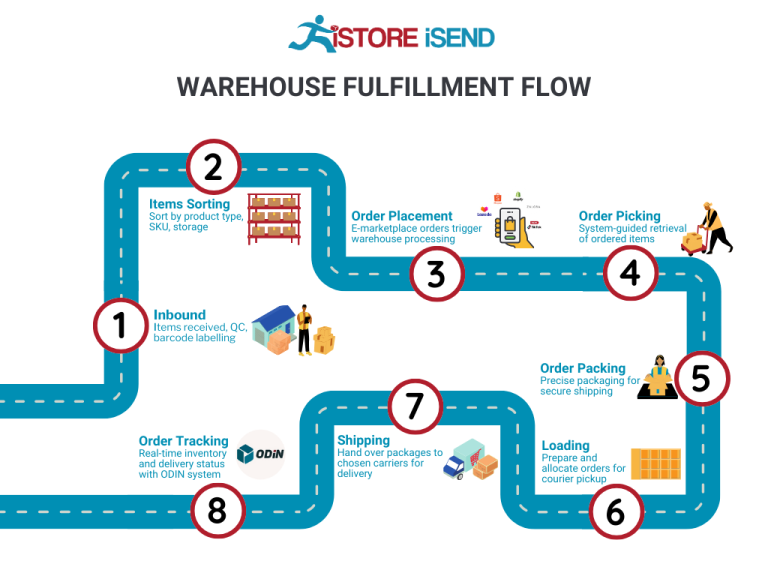
4. Order Packing
After the items have been picked, they move to the order packing stage. Here, the products are carefully packaged to ensure they arrive at the customer’s door in perfect condition. This step includes selecting appropriate packaging materials, adding invoices or promotional materials, and sealing the packages securely.
Packing is essential for protecting items during transit and enhancing the customer experience. A well-packed order reflects professionalism and care, which can influence repeat business. The term packing slip is relevant here, as it is a document included with the shipment that lists the items enclosed, serving as a reference for both the customer and the fulfillment team.
5. Shipping & Delivery
The final step in the order fulfillment process is shipping and delivery. Once orders are packed, they are labeled and prepared for shipment. This involves choosing the best shipping method based on factors like cost, speed, and customer preference. Fulfillment centers often use various carriers and logistics partners to optimize delivery routes.
This step is crucial because timely delivery can significantly impact customer satisfaction and loyalty. A term associated with this phase is last-mile delivery, which refers to the final leg of the shipping journey, where the package is delivered from a transportation hub to the customer’s doorstep. Efficient last-mile delivery strategies, such as utilizing local delivery services or Amazon Flex drivers, can enhance service levels and reduce delivery times, making your business more competitive in the e-commerce space.
Conclusion
Understanding and optimizing each step of the order fulfillment process is essential for e-commerce businesses looking to scale efficiently. By focusing on accurate inventory management, organized storage, effective picking, careful packing, and timely shipping, businesses can enhance customer satisfaction, reduce costs, and improve overall operational efficiency.
Comparing Fulfillment Models: In-House vs. 3PL vs. Dropshipping
Fulfillment Models Overview
In the evolving landscape of e-commerce, selecting the right fulfillment model is crucial for operational efficiency and customer satisfaction. Below is a comparative analysis of the three predominant fulfillment models: In-House Fulfillment, Third-Party Logistics (3PL), and Dropshipping.
| Model | Who Handles Inventory | Best For (Business Stage) | Key Advantage | Key Disadvantage |
|---|---|---|---|---|
| In-House Fulfillment | The business itself | Established businesses with stable demand | Full control over inventory and operations | High overhead costs and resource-intensive |
| Third-Party Logistics (3PL) | The 3PL provider | Growing businesses seeking scalability | Access to expertise and flexible solutions | Less control over inventory and fulfillment processes |
| Dropshipping | Supplier or manufacturer | Startups and small businesses | Low startup costs and minimal risk | Lower profit margins and potential quality issues |
In-House Fulfillment
In-House Fulfillment involves managing all aspects of inventory and order processing within the business itself. This model is most suitable for established companies that have a steady demand and can afford the investment in warehousing, staff, and logistics infrastructure.
Key Advantages:
The primary benefit of in-house fulfillment is the complete control it offers over inventory management and order fulfillment processes. Businesses can customize their operations to align with their specific needs, allowing for tailored customer experiences. Additionally, having direct oversight can lead to faster order processing times and improved quality control, as businesses are directly responsible for every aspect of their fulfillment operations.
Key Disadvantages:
However, this model comes with significant drawbacks, primarily the high overhead costs associated with maintaining a warehouse, purchasing inventory, and hiring staff. Businesses must also invest in technology and logistics systems to manage their operations effectively. For smaller businesses or those experiencing fluctuating demand, these costs can be burdensome and may hinder scalability.
Third-Party Logistics (3PL)
Third-Party Logistics (3PL) providers handle various aspects of the supply chain, including warehousing, inventory management, and shipping on behalf of businesses. This model is ideal for growing companies that need to scale their operations without the burdens of maintaining in-house logistics.
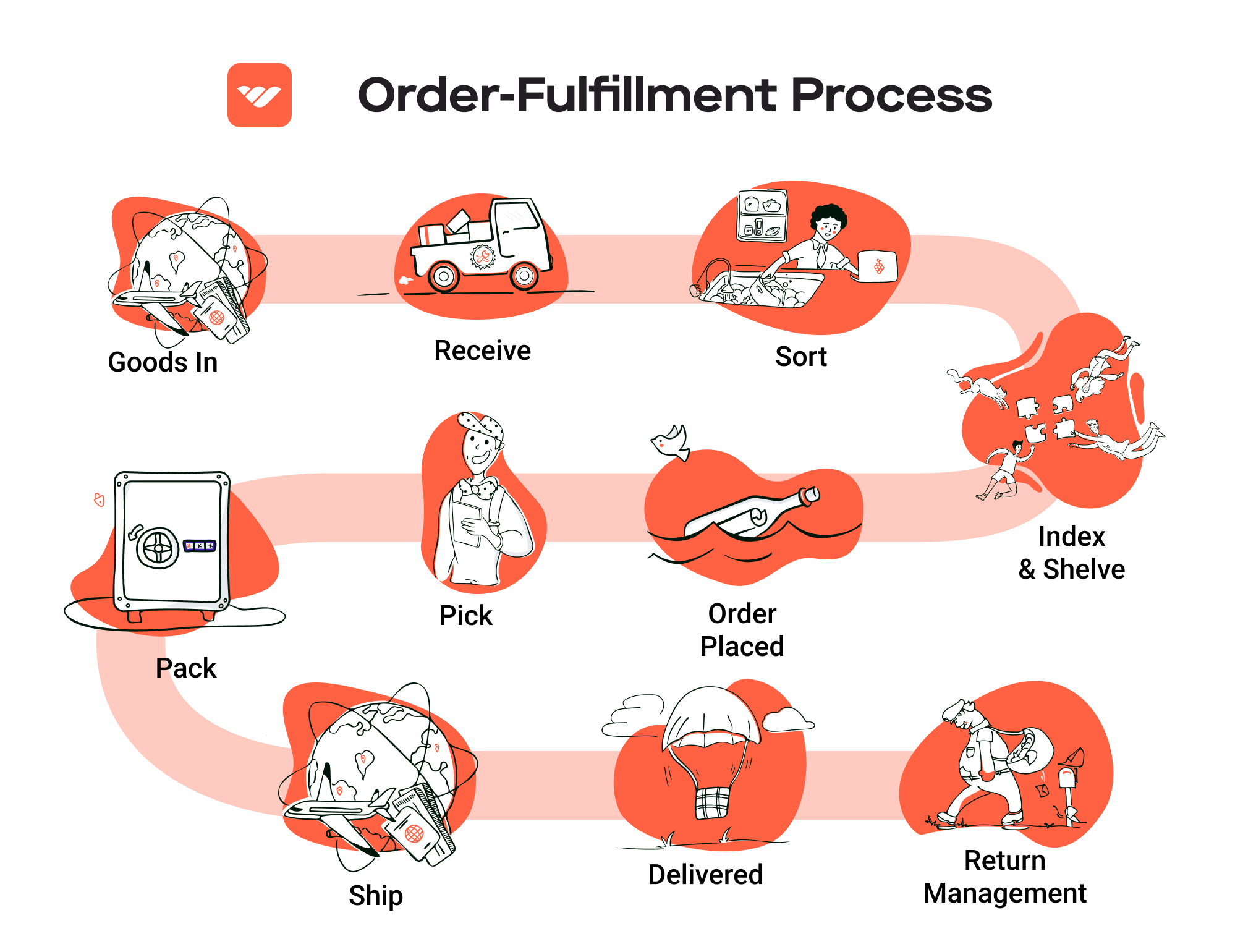
Key Advantages:
One of the significant advantages of using a 3PL provider is the ability to leverage their expertise and established logistics networks. These providers often have advanced technology and systems in place, which can lead to improved efficiency and reduced shipping times. Furthermore, partnering with a 3PL can free up valuable resources for businesses, allowing them to focus on core operations such as marketing and product development.
Key Disadvantages:
The primary disadvantage of 3PL is the reduced control businesses have over their inventory and fulfillment processes. Relying on an external provider can lead to potential misalignments in service quality and operational priorities. Additionally, businesses may face challenges with communication and coordination, especially if their 3PL provider operates on a different schedule or has varying operational standards.
Dropshipping
Dropshipping is a fulfillment method where businesses sell products without holding inventory. Instead, when a customer makes a purchase, the order is forwarded to a supplier or manufacturer, who then ships the product directly to the customer. This model is particularly appealing to startups and small businesses looking to minimize risk and startup costs.
Key Advantages:
The most significant advantage of dropshipping is the low barrier to entry. Entrepreneurs can start an e-commerce business without the need for significant capital investment in inventory or warehousing. This model allows for a broader product selection without the financial risk associated with unsold inventory. It also enables businesses to quickly adapt to market changes and consumer demands by easily adding or removing products from their offerings.
Key Disadvantages:
On the downside, dropshipping typically results in lower profit margins, as businesses often have to pay retail prices to their suppliers. Additionally, because they do not handle the products directly, there can be issues with quality control and shipping times, which can negatively impact customer satisfaction. Businesses may also face challenges in building a brand identity, as they have less control over the customer experience compared to in-house fulfillment.
Conclusion
Choosing the right fulfillment model is a pivotal decision for e-commerce businesses. Each model—In-House Fulfillment, 3PL, and Dropshipping—has its own set of advantages and challenges that must align with the business’s goals, size, and growth strategy. Understanding these models in depth can empower entrepreneurs and operations managers to make informed decisions that enhance their logistics capabilities and ultimately drive success in the competitive e-commerce landscape.
A Deep Dive into Amazon FBA: Pros, Cons, and Who It’s For
Understanding Fulfillment by Amazon (FBA)
Fulfillment by Amazon (FBA) is a service provided by Amazon that allows sellers to store their products in Amazon’s fulfillment centers. Amazon then takes care of storage, packaging, and shipping of these products to customers. This means that when a customer orders a product, Amazon handles all aspects of the fulfillment process, including customer service and returns. FBA can be an attractive option for e-commerce business owners looking to scale their sales without the overhead of managing their own logistics and fulfillment operations.
How FBA Works
-
Inventory Storage: Sellers send their products to Amazon’s fulfillment centers. Each product is assigned a unique identifier (SKU), and Amazon manages the inventory across its network of warehouses.
-
Order Processing: When a customer places an order for a product that is fulfilled by Amazon, the order is processed automatically. Amazon picks the product from its inventory, packs it, and ships it directly to the customer.
-
Shipping: Amazon provides fast shipping options, including Prime two-day shipping, which can significantly enhance the customer experience and increase sales potential.
-
Customer Service: Amazon handles all customer inquiries and returns related to FBA products. This can save sellers time and resources, allowing them to focus on other aspects of their business.
-
Multi-Channel Fulfillment: FBA can also fulfill orders from other sales channels, such as eBay or a seller’s own website, making it a versatile logistics solution.
Pros of Using FBA
-
Prime Eligibility: Products fulfilled by Amazon are eligible for Amazon Prime, which can lead to increased visibility and sales. Prime members are more likely to purchase products that offer free two-day shipping.
-
Customer Trust: Leveraging Amazon’s brand reputation can instill trust in customers. Buyers often feel more secure purchasing products that are fulfilled by Amazon due to their reliable service and return policies.
-
Scalability: FBA allows sellers to scale their business without the need to invest in warehousing, staff, or logistics. As sales grow, sellers can simply send more inventory to Amazon’s fulfillment centers.
-
Multi-Channel Fulfillment: Sellers can use FBA to fulfill orders from various platforms, allowing them to maintain a consistent inventory and shipping process across different sales channels.
-
Time Savings: By outsourcing fulfillment to Amazon, sellers can free up time to focus on product development, marketing, and other critical business functions.
Cons of Using FBA
-
High Fees: FBA comes with various fees, including storage fees and fulfillment fees, which can eat into profit margins. Sellers must carefully calculate these costs to ensure that their pricing strategy remains profitable.
-
Strict Inventory Rules: Amazon has specific guidelines for inventory management, including limitations on the types of products that can be stored in their warehouses. Sellers must comply with these rules to avoid penalties or account suspension.
-
Commingling Risks: FBA products from different sellers may be stored together, leading to potential issues with product quality and authenticity. If a seller’s product is returned or damaged, it may affect their reputation if it is mixed with other sellers’ inventory.
-
Limited Control: By using FBA, sellers relinquish control over the fulfillment process. This can lead to challenges if there are stockouts or issues with shipping times, as sellers may not have immediate visibility or recourse.
-
Complex Returns Process: While Amazon handles returns, the process can be complex for sellers, especially if they receive returned items that are damaged or not in sellable condition.
Who is FBA Best For?
FBA is best suited for sellers who:
-
Have High Sales Volume: Sellers with a steady or high sales volume can benefit from the efficiency and scalability of FBA, making it easier to manage large orders without a significant investment in logistics.
-
Sell Consumer Goods: Products that appeal to a broad audience, particularly those that are eligible for Prime, tend to perform well with FBA.
-
Want to Focus on Growth: Entrepreneurs who want to concentrate on scaling their business, marketing, and product development rather than logistics may find FBA to be a practical solution.
-
Are New to E-commerce: New sellers can take advantage of Amazon’s established infrastructure to reduce the complexity of launching their business, allowing them to learn the ropes without the steep learning curve of managing fulfillment.
-
Utilize Multiple Sales Channels: Businesses that sell on various platforms can streamline their fulfillment process by using FBA, ensuring consistent service across all channels.
In conclusion, Fulfillment by Amazon offers a robust solution for e-commerce sellers looking to streamline their logistics and improve customer satisfaction. While it comes with its challenges, understanding the pros and cons can help sellers make informed decisions about whether FBA aligns with their business goals.
Core Services Offered by Fulfillment Centers
Inventory Management & Warehousing
Inventory management is a critical component of e-commerce operations, and fulfillment centers excel in this area by offering sophisticated warehousing solutions. Fulfillment centers provide businesses with the ability to store their products in strategically located warehouses, which can significantly reduce shipping times and costs, especially for companies selling on platforms like Amazon.
These centers utilize advanced inventory management systems that allow e-commerce businesses to track stock levels in real-time. This means that you can easily monitor what products are available, which items are running low, and when it’s time to reorder. Such visibility helps prevent stockouts and overstock situations, optimizing inventory turnover and cash flow.
Additionally, warehousing services often include climate control, security, and organized shelving systems, ensuring that products are stored safely and efficiently. By outsourcing inventory management and warehousing to fulfillment centers, e-commerce businesses can focus more on their core operations, such as marketing and product development, rather than the logistical challenges of storage.
Pick and Pack Services
Pick and pack services are fundamental to the fulfillment process. This service involves the systematic retrieval of products from the warehouse (the “pick”) and their preparation for shipment (the “pack”). Fulfillment centers employ trained staff and automated systems to efficiently pick items from inventory and pack them according to specific customer orders.
The benefits of pick and pack services are substantial. First, they ensure accuracy in order fulfillment, which is critical for maintaining customer satisfaction. A well-executed pick and pack process minimizes the risk of errors, such as shipping the wrong items or quantities.
Moreover, fulfillment centers often employ various packing strategies, such as using eco-friendly materials or optimizing box sizes to reduce shipping costs. This can lead to significant savings for e-commerce businesses while also enhancing their brand image through sustainable practices. By outsourcing this process, businesses can scale their operations without the need to invest heavily in staffing and training for in-house fulfillment.
Kitting and Assembly
Kitting and assembly services are particularly beneficial for businesses that sell products that require bundling or assembly before they can be sold. This process involves grouping multiple items together into a single package, which can include anything from promotional bundles to complex product assemblies.
Fulfillment centers can handle this process efficiently, ensuring that products are assembled correctly and packaged attractively for customers. This not only saves time for e-commerce businesses but also allows them to offer unique product offerings that can differentiate them in a crowded market.
Furthermore, kitting and assembly can enhance operational efficiency by allowing businesses to streamline their product offerings. For example, instead of managing individual SKUs for each item in a bundle, companies can create a single SKU for the entire kit. This simplifies inventory management and reduces complexity in the fulfillment process, making it easier to scale operations.
Returns Management (Reverse Logistics)
Returns management, or reverse logistics, is an often-overlooked but essential service provided by fulfillment centers. As e-commerce continues to grow, so does the rate of returns, making it crucial for businesses to have an efficient returns process in place. Fulfillment centers can manage this process seamlessly, handling everything from the return of products to restocking them in inventory.
Effective returns management offers several advantages. Firstly, it helps maintain customer satisfaction by providing a hassle-free return process, which is increasingly expected by consumers. A smooth return experience can turn a potentially negative interaction into a positive one, encouraging repeat purchases.
Additionally, fulfillment centers can analyze return data to identify trends, such as which products are frequently returned and why. This information can be invaluable for businesses looking to improve product quality, adjust marketing strategies, or refine their offerings. By outsourcing returns management to fulfillment centers, e-commerce businesses can reduce the operational burden and focus on growth strategies.
Conclusion
Utilizing fulfillment centers for core services such as inventory management, pick and pack, kitting and assembly, and returns management can significantly enhance the efficiency and scalability of e-commerce operations. By leveraging these specialized services, businesses can optimize their logistics processes, reduce costs, and ultimately provide a better customer experience. This allows e-commerce companies to focus on what they do best—growing their brand and serving their customers.
How to Choose a Fulfillment Partner: A 6-Point Checklist
Location & Warehouse Network
When selecting a fulfillment partner, the geographical location of their warehouses is a critical factor. Proximity to your customer base can significantly impact shipping times and costs, which are essential for maintaining customer satisfaction and loyalty.
Key Considerations:
– Proximity to Key Markets: Identify where most of your customers are located and ensure the fulfillment center is near these areas.
– Warehouse Density: A network of warehouses can facilitate faster shipping through strategic distribution. Ask potential partners about their warehouse locations and how they plan to optimize shipping routes.
Questions to Ask:
1. What is the location of your fulfillment centers, and how do they align with my customer demographics?
2. How many warehouses do you operate, and what is the average shipping time to key markets?
3. Do you have plans for expanding your warehouse network in the future?
Technology & Integrations
In today’s e-commerce landscape, technology is a game-changer. A fulfillment partner should offer a robust technology platform that integrates seamlessly with your existing systems, such as your e-commerce platform, inventory management, and customer relationship management tools.
Key Considerations:
– Order Management System (OMS): Ensure the partner has a reliable OMS that provides real-time tracking and updates.
– Integration Capabilities: The ability to integrate with your current software stack can save time and reduce errors.
Questions to Ask:
1. What technology platform do you use for order fulfillment, and how does it integrate with e-commerce platforms like Shopify or Amazon?
2. Can you provide real-time updates on order status, inventory levels, and shipping information?
3. What is your process for handling technical issues or system downtimes?
Specializations (e.g., Cold Storage, Oversized Items)
Different businesses have unique needs, and not all fulfillment centers can handle specialized products. If you sell items that require special handling, such as perishables, oversized goods, or hazardous materials, it’s essential to partner with a fulfillment center that has the necessary capabilities.
Key Considerations:
– Specialized Equipment: Verify if the fulfillment partner has the infrastructure needed for your specific products, such as temperature-controlled storage for food items.
– Experience with Niche Markets: A partner with experience in your industry will understand the nuances of handling your products.
Questions to Ask:
1. Do you have specialized facilities or equipment for handling my product type?
2. Can you provide examples of other clients in my industry that you have successfully supported?
3. What certifications do you have for handling specialized products (e.g., FDA, USDA)?
Scalability & Capacity
As your business grows, your fulfillment needs will change. It’s crucial to choose a partner that can scale operations with you, whether it’s accommodating seasonal spikes in demand or expanding your product line.
Key Considerations:
– Flexible Capacity: Understand how the partner manages capacity during peak seasons or sudden growth.
– Long-Term Growth Plans: Ensure that the partner can adapt to your future business requirements.
Questions to Ask:
1. How do you manage capacity during peak seasons or unexpected surges in demand?
2. What is your process for scaling operations, and how quickly can you respond to growth?
3. Are there any restrictions or limitations on the types of products or volumes you can handle?
Pricing and Contracts
Understanding the pricing structure and contract terms is vital to ensure that you are making a financially sound decision. Hidden fees or unfavorable terms can significantly impact your bottom line.
Key Considerations:
– Transparent Pricing: Ensure that pricing is clear and straightforward, with no hidden fees for services like storage, packing, or shipping.
– Contract Flexibility: Look for partners that offer flexible contract terms, allowing you to adjust as your business evolves.
Questions to Ask:
1. Can you provide a detailed breakdown of your pricing model, including any potential hidden fees?
2. What are the terms of the contract, and do you offer flexibility for scaling or changing service levels?
3. How do you handle pricing changes, and will I be notified in advance?
Customer Support & Reviews
Excellent customer service can make a significant difference in your experience with a fulfillment partner. Responsive support can help resolve issues quickly, ensuring minimal disruption to your operations.
Key Considerations:
– Availability of Support: Look for partners that offer multiple channels of support (e.g., phone, email, live chat).
– Reputation and Reviews: Research online reviews and testimonials to gauge the partner’s reliability and service quality.
Questions to Ask:
1. What customer support options do you offer, and what are your response times?
2. Can you provide references or case studies from other clients?
3. How do you handle customer service issues, and what is your process for resolving disputes?
By carefully evaluating these six key areas, you can make a well-informed decision when choosing a fulfillment partner that aligns with your business goals and customer needs. This thorough assessment will help ensure that you select a partner capable of supporting your growth and providing a seamless fulfillment experience.
Understanding Fulfillment Pricing: A Breakdown of Common Fees
Initial Setup Fees
When engaging with Amazon fulfillment centers or any third-party logistics (3PL) provider, the initial setup fee is a crucial cost to consider. This fee is typically a one-time charge that covers the administrative work required to onboard your account, including system integration, account setup, and initial consultations. Depending on the complexity of your operations and the volume of products you plan to send to the fulfillment center, these fees can vary widely.
For example, if you’re migrating from another fulfillment provider, you might incur additional costs for inventory transfer and system compatibility checks. It’s essential to clarify what’s included in the setup fee; some providers may offer additional services such as training on their systems or software as part of this initial investment.
Receiving Fees
Receiving fees are charged when your inventory arrives at the fulfillment center. This fee compensates the facility for unloading, inspecting, and storing your products. The cost can be calculated per unit or per pallet, depending on how your inventory is packaged.
For instance, if you send a shipment of 1,000 units and the receiving fee is $0.50 per unit, your total receiving fee would be $500. It’s important to note that receiving fees can also vary based on the type of goods being received; larger or more complex items may incur higher fees due to additional handling requirements. Be sure to ask about any potential surcharges for special handling or inspection.
Storage Fees (per pallet/bin)
Storage fees are ongoing charges for keeping your inventory in the fulfillment center. They are typically calculated on a per-pallet or per-bin basis and can vary depending on the time of year. For example, during peak seasons like the holidays, storage fees may increase due to higher demand for warehouse space.
Most providers will charge a monthly fee based on the space your inventory occupies. For instance, if you store 10 pallets at a rate of $20 per pallet, your monthly storage fee would be $200. Additionally, it’s crucial to be aware of any long-term storage fees that may apply if your inventory remains unsold for an extended period, typically over six months. Understanding your inventory turnover will help you manage these costs effectively.
Pick & Pack Fees (per item/order)
Pick and pack fees are charged for the labor involved in retrieving items from storage and preparing them for shipment. This fee can be structured in several ways: per item, per order, or a combination of both.
For example, if a fulfillment center charges $1.00 per item and you have an order of 10 items, the pick and pack fee would total $10. Alternatively, some providers may offer a flat fee per order, regardless of the number of items. It’s essential to evaluate your typical order size and frequency to determine which pricing model is most cost-effective for your business. Additionally, inquire about any fees for special packing requirements, such as gift wrapping or branded packaging.
Shipping Fees
Shipping fees are perhaps the most variable costs associated with fulfillment services, as they depend on several factors, including the destination, weight, and dimensions of the package. Most fulfillment centers leverage shipping partnerships to offer competitive rates, but it’s crucial to understand how these fees are calculated.
Typically, shipping fees will be based on the carrier’s pricing, which can include options for standard, expedited, or same-day delivery. For instance, if you are shipping a 5-pound package within the continental U.S. and the cost is $8.00 for standard shipping, this fee will be added to your total fulfillment costs. Additionally, be aware of any surcharges that may apply for remote locations or special handling.
Tips for Getting an Accurate Quote
-
Provide Detailed Information: When requesting a quote, ensure you provide detailed information about your products, including dimensions, weights, and packaging requirements. This helps the fulfillment center give a more accurate estimate.
-
Understand Your Volume: Be clear about your expected order volume and frequency, as many fulfillment centers offer tiered pricing based on order volume, which can significantly affect your overall costs.
-
Ask About Additional Fees: Inquire about any potential additional fees that may not be included in the initial quote, such as long-term storage fees, special handling charges, or seasonal rate increases.
-
Negotiate Terms: Don’t hesitate to negotiate terms and fees based on your business needs. Many fulfillment centers are willing to offer discounts for long-term contracts or higher volumes.
-
Review the Contract: Carefully review the fulfillment contract to understand all fee structures and terms. Look for any clauses regarding fee increases, especially during peak seasons.
By taking these steps, you can ensure that you receive a comprehensive and accurate quote, enabling you to make informed decisions as you scale your e-commerce operations.
Frequently Asked Questions (FAQs) about Fulfillment
1. What is the role of Amazon fulfillment centers in Georgia?
Amazon fulfillment centers in Georgia serve as strategic hubs for storing and processing inventory. They facilitate the picking, packing, and shipping of products directly to customers, ensuring faster delivery times, especially for Prime members. Their locations are strategically placed to optimize delivery routes across the state and beyond.
2. What is the difference between a warehouse and a fulfillment center?
While both warehouses and fulfillment centers store products, their functions differ significantly. A warehouse primarily focuses on storing goods for long periods, whereas a fulfillment center is designed for rapid processing and distribution of orders. Fulfillment centers handle the entire order fulfillment process, including inventory management, order processing, and shipping.
3. How many Amazon fulfillment centers are located in Georgia?
Georgia is home to approximately 40 verified Amazon fulfillment centers, including various types such as fulfillment centers (FC), sortation centers (SC), and distribution centers (DC). Most are concentrated around major population centers like Atlanta, Macon, and Savannah.
4. What types of facilities does Amazon operate in Georgia?
Amazon operates several types of facilities in Georgia, including:
– Fulfillment Centers (FC): Where orders are picked, packed, and shipped.
– Sortation Centers (SC): Where packages are sorted before final delivery.
– Distribution Centers (DC): Larger facilities that handle bulk inventory and supply chain logistics.
– Delivery Stations (DS): Facilities where packages are prepared for last-mile delivery.
5. How much do fulfillment services cost?
The cost of fulfillment services varies widely based on factors such as order volume, storage needs, and specific services required. Generally, fulfillment centers may charge fees based on storage space (per cubic foot), order processing (per order or item), and additional services like returns handling. Businesses should request quotes from fulfillment providers to get tailored pricing.
6. What is a 3PL and how does it relate to Amazon fulfillment?
A 3PL, or third-party logistics provider, is a company that manages logistics services for other businesses. In the context of Amazon fulfillment, some sellers may choose to partner with 3PLs to handle their inventory and distribution needs, especially if they operate on multiple platforms outside Amazon. This can provide flexibility and additional expertise in logistics management.
7. How does Amazon ensure fast delivery from its fulfillment centers in Georgia?
Amazon utilizes advanced logistics technology, optimized routing, and strategically located fulfillment centers to ensure fast delivery. With many centers close to major population hubs, Amazon can efficiently fulfill orders and offer services like same-day or two-day delivery, particularly for Prime members.
8. Are there any Amazon fulfillment centers in Atlanta?
Yes, Atlanta is home to several Amazon fulfillment centers, including the ATL2 center located in Stone Mountain. This center serves the greater Atlanta area and helps facilitate quick order fulfillment for customers in and around the city.
9. What are the working conditions like at Amazon fulfillment centers in Georgia?
Working conditions at Amazon fulfillment centers can vary by location, but many facilities in Georgia have received positive reviews regarding their work environment. However, like many large-scale operations, there have been reports and protests regarding working conditions and employee treatment. It’s advisable for potential employees to research specific fulfillment centers for reviews and experiences.
10. How can e-commerce businesses benefit from using Amazon fulfillment centers in Georgia?
E-commerce businesses can benefit from using Amazon fulfillment centers by gaining access to Amazon’s extensive logistics network, which can significantly reduce shipping times and costs. Utilizing these centers allows businesses to scale operations without the need for investing in their own warehousing and logistics infrastructure, thus enabling them to focus on sales and customer service.
Conclusion: Is Outsourcing Fulfillment the Right Move for Your Business?
The Case for Outsourcing Fulfillment
In the fast-paced world of e-commerce, the decision to outsource fulfillment can be a game-changer for your business. By partnering with a fulfillment service, you can unlock several key benefits that can significantly enhance your operations.
First and foremost, outsourcing fulfillment saves you valuable time. Managing inventory, packing orders, and handling shipping logistics can be overwhelming, especially as your sales volume increases. A dedicated fulfillment partner can take these responsibilities off your plate, allowing you to focus on more strategic activities such as marketing, product development, and customer engagement.
Scalability is another compelling reason to consider outsourcing. As your business grows, so do the complexities of your supply chain. A fulfillment center, especially one located strategically in a populous area like Georgia, can easily adapt to your changing needs. Whether you experience seasonal spikes in demand or plan to expand your product line, a proficient fulfillment partner can provide the flexibility required to meet your evolving requirements without the need for significant capital investment.
Moreover, leveraging the expertise of a fulfillment service can improve operational efficiency and customer satisfaction. These partners often have advanced technology and logistics systems in place, ensuring faster processing times and accurate inventory management. Their experience in handling logistics can also lead to better shipping rates and improved delivery times, which are crucial for maintaining a competitive edge in the e-commerce landscape.
However, the success of outsourcing fulfillment hinges on selecting the right partner. It’s essential to conduct thorough research and choose a provider that aligns with your business goals, understands your industry, and has a proven track record of reliability.
To determine if outsourcing fulfillment is the right next step for your business, consider conducting an audit of your current shipping process. Evaluate the time, resources, and costs associated with your existing operations. This analysis will provide you with valuable insights into whether a fulfillment partner could enhance your efficiency and support your growth trajectory. Taking this proactive step could lead to significant improvements in both your bottom line and customer experience.
Important Disclaimer
⚠️ Important Disclaimer
The information in this guide is for educational purposes. Fulfillment services, pricing, and platform features change frequently. Always conduct your own due diligence and consult with providers directly before making business decisions.
